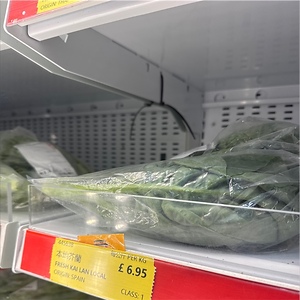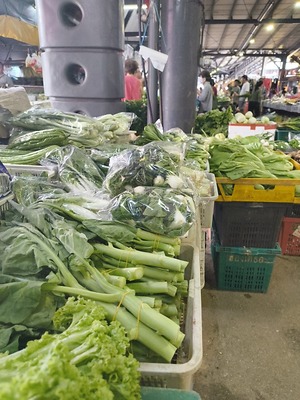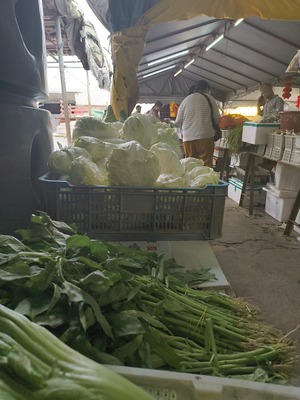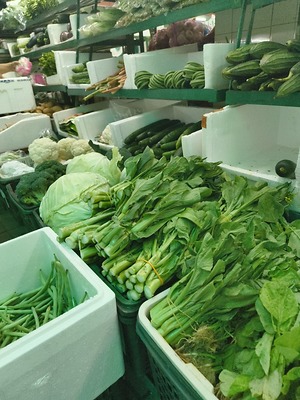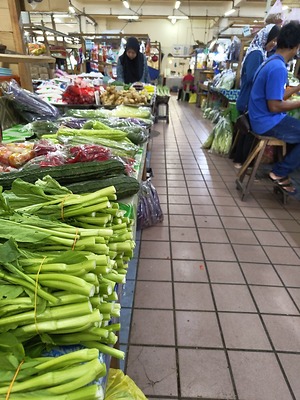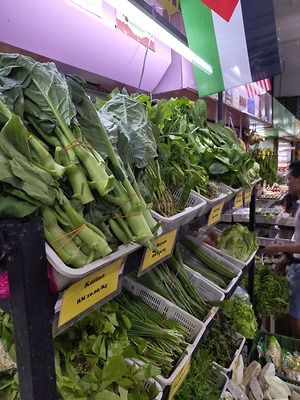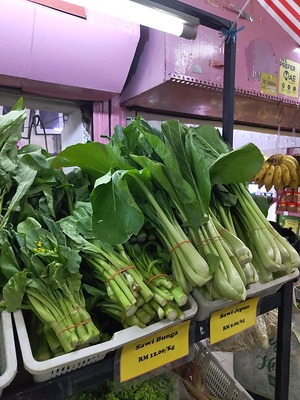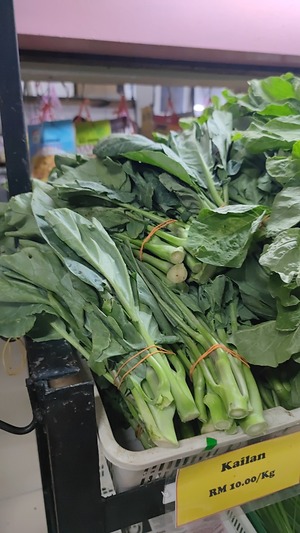


Gai Lan
Estimated Inventory, 30 lbs : 3.68
This item was last sold on : 07/17/25
Description/Taste
Gai Lan varies in size and shape, depending on the variety and age at harvest. The stems and leaves can be collected when they are in their baby stage or picked just before flowering, when they have reached 15 to 20 centimeters in length. The stems are thick, cylindrical, fleshy, and firm, growing upright and branching. The stems bear a pale green to dark green coloring and are smooth, crunchy, and chewy. The leaves appear at the ends and in alternate formations along the stems and have a broad, flat, and pliable nature. The leaves are matte green and characteristically have wavy edges and light veining. Some varieties of Gai Lan may showcase purple accents, while others will be entirely green. Gai Lan also produces small, broccoli-like florets containing tiny green buds that eventually open to reveal white or yellow flowers. Selecting Gai Lan bunches in markets without open buds is recommended, as flowering may be a sign that the stems have become woody and fibrous. Gai Lan is edible raw or cooked, but is mostly cooked to develop a soft, tender, and crunchy consistency. The flavor is strong, bitter, and subtly sweet when raw, mellowing once cooked to a green, vegetal, and subtly bittersweet taste.
Seasons/Availability
Gai Lan is available year-round, with a peak season in the fall through spring.
Current Facts
Gai Lan, botanically classified as Brassica oleracea var. alboglabra, is a culinary ingredient belonging to the Brassicaceae family. The cool-season crop is native to China and has expanded in cultivation to farms and gardens worldwide. Gai Lan is typically harvested 60 to 70 days after sowing and is commercially grown as a versatile, everyday vegetable. Many varieties of Gai Lan are cultivated worldwide, and the species can be picked in multiple stages of maturity for various uses. Gai Lan is the Cantonese name for the plant, sometimes known as Kai Lan. It is also called Chinese Kale, Chinese White Kale, and Chinese Broccoli in English-speaking countries, Jie Lan in Mandarin, Cai Ro or Cai Lan in Vietnamese, and Kana in Thai. Gai Lan is prized for its strong flavor and thick, crunchy stems. The species is incorporated into savory dishes by chefs and home cooks and is valued for its ability to be used fresh or cooked in culinary preparations.
Nutritional Value
Gai Lan is a source of fiber, which aids digestion, and provides vitamins A, B, C, E, and K to guard the cells against free radical damage, strengthen the immune system, maintain healthy organs, and contribute to faster wound healing. Gai Lan also contains minerals, including calcium, iron, potassium, copper, manganese, and magnesium. Calcium supports bone and teeth health, iron develops the protein hemoglobin for oxygen transport through the bloodstream, while potassium balances fluid levels within the body. Copper assists in producing red blood cells, manganese helps with metabolism, and magnesium protects daily nerve functions. In Traditional Chinese Medicine, Gai Lan is believed to detox and cleanse the body due to its bitter nature.
Applications
Gai Lan has a subtly bitter, green, and vegetal taste suited for cooked preparations. Young and tender leaves and flower tips can be eaten raw in salads, but Gai Lan’s bitter nature is mostly preferred after cooking and combined with sauces and aromatics to balance flavors. The stem ends should be trimmed before being used to remove any fibrous portions, and separating the stems from the leaves is also recommended. The leaves will have a faster cooking time than the stems and should be added at the end of cooking. If the stems are thick, they may be peeled and sliced in half to create a more tender texture. Gai Lan is traditionally stir-fried, steamed, blanched, braised, or boiled. In China, the stems and leaves are often stir-fried with aromatics like garlic and ginger and then served in a sauce made from oyster, sugar, mirin, and chicken broth. Gai Lan is known for its stronger flavor and is used in dishes to enhance milder ingredients like steamed fish. It is also simmered into vegetable and noodle soups or tossed with meats as a main dish. While Gai Lan is primarily a Chinese culinary ingredient, it has also expanded its use to Thai, Vietnamese, Burmese, and Asian fusion dishes worldwide. Try substituting Gai Lan in beef and broccoli dishes or wrapping thinly sliced meats around the stems and grilling. The leaves also flavor dishes and are often stir-fried as a simple side or mixed into rice. Gai Lan pairs well with meats like beef, pork, and lamb, sesame seeds, mushrooms, black pepper, and white pepper. Whole, unwashed Gai Lan will keep for 3 to 7 days when loosely placed in a bag in the crisper drawer of the refrigerator. The stems can also be blanched and frozen for extended use.
Ethnic/Cultural Info
Gai Lan is a part of a local tale in Taoshan Village of the Guangdong Province. Legend has it that Emperor Qianlong stopped in the village one night on a tour. The emperor awoke early the next morning and went out for a stroll by himself. He discovered a garden filled with green vegetables, rumored to have contained Gai Lan, and as he moved through the garden, he heard laughter. The emperor looked up and noticed a beautiful girl dressing with the help of her maid in a window above the garden. It is said the girl was more beautiful than all three thousand women in the emperor’s harem. The maiden noticed the man staring at her, not knowing it was the emperor, and in her embarrassment, she threw a bowl of water out the window at him that was used for washing her face. The water only reached the tips of the emperor's shoes, making the emperor laugh. Instead of getting angry, the emperor recited lines of poetry about the sweet fragrance of the water drifting over the vegetables in the garden. This folklore established Gai Lan as a favorite vegetable in the village, and it was allegedly retold to share the passion for the versatile ingredient.
Geography/History
Gai Lan is believed to have been created in China and is a descendant of ancient Brassica species. The origins of various Brassica species are heavily debated. One theory notes that early Brassica species from the Mediterranean were carried along trade routes and were planted in China in ancient times. After their arrival, Chinese farmers selectively bred new types of Brassica plants with varying characteristics for culinary use. Gai Lan is thought to have arisen from the Guangdong Province in Southern China. The earliest known record appeared in the book “Miscellaneous Notes from Lingnan,” written by Wu Zhenfang in the early Qing Dynasty. In his book, Chinese kale, another name for Gai Lan, is mentioned as a vegetable eaten by Huineng, the sixth patriarch of Buddhism in the 7th century CE. Over time, Gai Lan expanded in cultivation throughout China and was later introduced to neighboring countries as a culinary ingredient. In 1989, the plant was notably crossed with broccoli by a Japanese seed company, eventually producing broccolini, a vegetable popularly sold worldwide in the modern day. Today, Gai Lan is primarily grown in Asia and is also cultivated as a specialty green in markets worldwide. Gai Lan is sold through fresh markets, grocers, and wholesalers.
Featured Restaurants
Restaurants currently purchasing this product as an ingredient for their menu.
| Bali Hai Restaurant | San Diego CA | 619-222-1181 |
| Bar Same Same (Kitchen) | Carlsbad CA | 760-470-9143 |
| The Plot Restaurant (Costa Mesa) | Costa Mesa CA | 714-852-3181 |
| Cesarina | San Diego CA | 619-226-6222 |
| Georges at the Cove | San Diego CA | 858-454-4244 |
| The Flavor Chef (Catering) | Vista CA | 619-295-3172 |
| Cloak and Petal | San Diego CA | 626-319-6878 |
| Roppongi (IB) | Imperial Beach CA | 858-456-8018 |
| Common Theory | San Diego CA | 858-384-7974 |
| Rosewood Social | San Juan Capistrano CA | 669-243-8403 |
Recipe Ideas
Recipes that include Gai Lan. One



